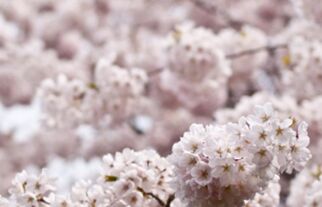关于樱花你可能不知道的10件事
|
1. YOU'LL ONLY FIND CHERRY BLOSSOMS IN A HANDFUL OF COUNTRIES. Called sakura in Japan, the cherry blossoms of Yoshino and Kyoto are world-famous. Tourists flock to the country each spring to try their hand at a centuries-old activity called hanami, or “flower viewing.” You don’t have to fly to Japan to see them, though. In the US, the cherry blossoms of Washington, D.C., New York City, Philadelphia, St. Louis, Seattle, San Francisco, and Boston are all beautiful in their own way. The flowers can also be viewed in many European and Asian countries, as well as Brazil and Australia in the southern hemisphere.
2. THE CHERRY BLOSSOM CAPITAL OF THE WORLD IS IN THE STATE OF GEORGIA. Believe it or not, the city of Macon in central Georgia is recognized as the “Cherry Blossom Capital of the World”—at least according to US Congressional records. It’s home to 350,000 Yoshino cherry trees, while Washington, D.C. has fewer than 4000 trees. 3. THERE ARE HUNDREDS OF CHERRY TREE VARIETIES. Japan in particular is home to hundreds of types of cherry tree—possibly more than 600, by more liberal estimates. Some types bear fruit, while others don’t. The flowers of many trees change from dark pink to light pink to white throughout the different stages of blossoming, while others progress from greenish yellow to white to pink. One variety, called Kanzan, was bred to have “double blossoms”—or up to 28 petals on each flower, compared to the Yoshino tree’s five petals. 4. THEY DON'T BLOOM FOR LONG. A cherry tree might only remain in bloom for one to two weeks. However, they only keep up their “peak color” for about three days, so it’s best to time your trip wisely if you’re visiting a cherry blossom destination from out of town. The timing depends on a number of factors, including location, heat, and daylight. 5. CLIMATE CHANGE COULD BE MAKING THEM BLOSSOM EARLIER. Some scholars have suggested that the trees are blooming earlier and earlier as the planet gradually gets warmer. Dr. Soo-Hyung Kim, an ecophysiologist at the University of Washington who has studied the phenomenon, says that by 2080 we could expect to see cherry blossoms in D.C. as early as February. 6. YOU CAN GET ARRESTED FOR PLUCKING A CHERRY BLOSSOM IN WASHINGTON, D.C. Resist the urge to take a cherry blossom home with you as a souvenir. In D.C. at least, breaking off a blossom or branch is viewed as vandalism of federal property. Those who break this rule could receive a citation, or worse, be arrested. It goes without saying that it’s also illegal to climb the trees. If they sustain damage to their branches, they will never be able to grow new blossoms on that particular bough again. 7. THE VERY FIRST CHERRY TREES TO ARRIVE IN AMERICA WERE A COMPLETE DISASTER. In 1909, Japan offered to send 2000 cherry trees to America as a symbol of friendship between the two countries. Despite the good intentions, the execution was disastrous. When the trees arrived in D.C. in January 1910, the trees were weak—due to overpruning of their roots—and they were also infested with wood-boring insects. Despite attempts to save them, the trees were ultimately thrown in a pile and burned. Everyone was pretty embarrassed about the whole ordeal, but Tokyo mayor Yukio Ozaki made a joke to ease some of the tension. “To be honest about it, it has been an American tradition to destroy cherry trees ever since your first president, George Washington,” he said. “So there’s nothing to worry about. In fact, you should be feeling proud.” (Washington's cherry tree story turned out to be untrue) Another shipment of trees was sent, and by 1912, the healthy trees were successfully planted in D.C. by then-First Lady Helen Taft. 8. THE CHERRY TREES IN ONE DUTCH MUNICIPALITY HAVE PROPER NAMES. Located in the largest park in the Netherlands, all 400 cherry blossom trees have proper names. Half of them have traditional Dutch women’s names, and the other half have Japanese women’s names. The Japan Women’s Club gifted the trees in 2000, and you can now find them at Amsterdamse Bos (Amsterdam Forest) in the Amstelveen municipality. 9. BOTH THE BLOSSOMS AND LEAVES ARE EDIBLE. In Japan, no part of the cherry blossom tree goes to waste. The preserved leaves are used as edible mochi wrappers (a rice cake filled with sweet bean paste), and a number of seasonal snacks feature sakura as a key ingredient. Sakura-infused versions of Pepsi, Coke, tea, and even Starbucks lattes are all popular drinks. You can also find Kit Kats and Pocky snack sticks that taste like sakura. 10. THEY WERE THE INSPIRATION BEHIND A RECORD-SETTING LEGO SCULPTURE. LEGOLAND Japan, a theme park in Nagoya, set a Guinness World Record in 2018 for the largest LEGO brick cherry blossom tree ever made. The tree stood 14 feet tall, weighed over 7000 pounds, and consisted of more than 800,000 LEGO bricks. |









